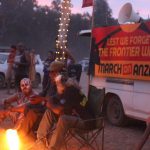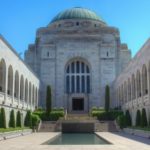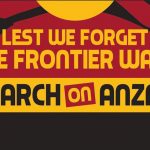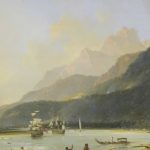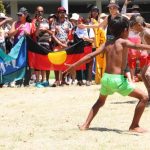Colonising First Nations: From the Killing Times to Reserves to Incarceration
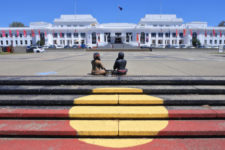
The British colonisation of the continent now referred to as Australia was based on terra nullius, meaning the land was neither owned nor occupied. As the High Court of Australia acknowledged in 1992, this was a lie, which was obvious to the First Nations peoples and the invaders at the time.
The problem for the British as they pursued their takeover of the land was that it was already being occupied by the locals. So, in order to deal with this setback, the invaders undertook policies of genocide, segregation and then incarceration: a measure still being utilised to this day.
Soon after the arrival of the British ships in the Warrang/Sydney region an outbreak of smallpox struck down around 90 percent of the local First Nations population, which some assert was an act of biological warfare, with the disease purposefully being deployed.
And this was accompanied by a wave of violence that eventually spread out across the continent as the British moved in to acquire more land. This encompassed fierce First Nations resistance, as well as wholesale massacres perpetrated by foreigners equipped with firearms.
Against the unarmed
Historian Tony Roberts gives an account of the killing times in the Gulf Country of the Northern Territory in his essay The Brutal Truth. Commencing in 1881, stock stations were established in the region, which involved the “state-sanctioned” slaughter of one sixth of the Indigenous population.
By 1910, around 600 Aboriginal men, women and children were wiped out as part of the land grab, which also saw the dispossession of 4,000 locals within a four year period. And this was all perpetrated in the name of a failed enterprise: many of the stations were abandoned or downsized.
Prior to the “pastoral boom”, there are accounts of white travellers passing through the north and mowing down the inhabitants at a distance using their “state-of-the-art rifles”, as well as reports of police being sent in to slaughter camps as retribution for transgressions, such as spearing cattle.
And this violence, which often went undocumented, was in no way confined to the NT. Take Tasmania, for example, in February 1830, the colonial government put out a bounty on Aboriginal people: £5 per adult and £2 per child.
To the margins and rationed
Policies of “protection” were implemented throughout the various colonies starting in the late 1800s and continuing into the early decades of the next century. Theses involved systems of segregation whereby First Nations peoples were moved onto missions and managed or unmanaged reserves.
Protection laws were enacted, which created an alternative regulatory system for Aboriginal and Torres Strait Islander peoples. This gave the colonial government control over all aspects of their lives, as well as allowing the authorities to remove children and place them in boarding schools.
In NSW, the Aboriginal Protection Board was created in 1883, although it’s work was not supported by legislation until the passing of the 1909 Aborigines Protection Act. This and later legislation allowed for the board to assume full control and custody over Aboriginal children.
The 1909 legislation provided NSW police with the powers to issue rations, patrol unsupervised reserves, expel troublemakers, remove children from their parents, evict light-skinned Aboriginal people from reserves and institute proceedings to remove communities from certain localities.
UTS School of Design Associate Professor of Indigenous research Dr Jason De Santolo said that the reserve system changed everyday life for First Nations peoples. It “made us rely more on the colonial way of life. The ration days began. The slavery days began”.
A shift in policy
As the Australian Law Reform Commission’s 2017 Pathways to Justice report outlines some academics have drawn a correlation between the end of the reserves – “an alternative system of penality” – and the rise of Indigenous people being locked up in the mainstream Australian prison system.
With the advent of the national prison census in 1982, the overrepresentation of First Nations peoples inside became apparent. And it was around this time that growing concerns arose around the high number of Aboriginal deaths in custody.
Madeline Christine Jacobs gives a similar account of what happened to Indigenous peoples under the Canadian system in her 2012 doctorate Assimilation Through Incarceration. She maintains that the disproportionate imprisonment of First Peoples was “a strategic instrument of assimilation”.
“Colonial consciousness could not reconcile evolving Indigenous identities,” Ms Jacobs writes of the situation in Canada, “with projects of state formation founded on the epistemological invention of populating idle land with productive European settlements.”
A tool of dispossession
“Incarceration is a key element of the system,” Dr De Santolo told Sydney Criminal Lawyers. “By dehumanising people we are able to treat them in ways that maintain rule and domination.”
The Garrwa and Barunggam man further posits that human rights frameworks set out under the international treaties “don’t apply to the dehumanised population or the frameworks are interpreted and enacted through western systems” that don’t recognise First Nations sovereignty.
According to De Santolo, today, mining and extractive industries are playing their role in the ongoing dispossession project by contaminating First Nations’ “homelands and in that way removing the native from the lands once again”.
Most heavily imprisoned on Earth
The Royal Commission into Aboriginal Deaths in Custody report recommended that both arrest and incarceration be measures of last resort. At the time this document was table in 1991, Aboriginal and Torres Strait Islander people made up 14 percent of the adult prisoner population.
Twenty eight years on, First Nations inmates now account for 28 percent of adults currently being incarcerated in this county. And this is while Indigenous people only account for about 2.8 percent of the general populace.
Australian policies and processes penalise “our people through punitive systems”, Dr De Santolo continued. “And systems that target our youth are reflected in places like Don Dale: a tin shed in the tropics that tortures our youth.”
First Nations solutions
But, as Dr De Santolo stresses, powerful resistance within First Nations communities continues. And he pointed to Dylan Voller who spoke out against the racist violence in the NT youth justice system, even after he himself had been subjected to it.
The doctor explained that many reforms are needed, which could be motivated via a major research project where Aboriginal researchers use Indigenous methodologies to explore the racism and bias in the system, with an emphasis on women and men within the “private prison complex”.
“Up home, my Elders, brothers and sisters who are leaders in the community, are taking our young people out bush to reconnect and learn,” Dr De Santolo concluded.
“It seems to work well as part of the journey of healing and as a strategy to escape the turnstiles of the legal system that is targeting our people under the NT Intervention, now rebranded as Stronger Futures.”


